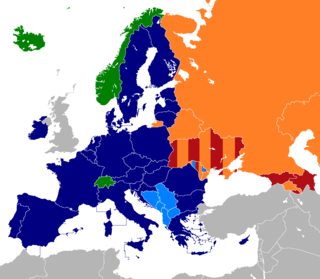List of customs territories
Unions
Countries which are members of a customs union, which in some cases may be considered a single customs territory: [2]
- Andean Community of Nations (CAN)
- Caribbean Community (CARICOM)
 Antigua and Barbuda
Antigua and Barbuda  Barbados
Barbados  Belize
Belize  Dominica
Dominica  Grenada
Grenada  Guyana
Guyana  Jamaica
Jamaica  Montserrat
Montserrat  Saint Kitts and Nevis
Saint Kitts and Nevis  Saint Lucia
Saint Lucia  Saint Vincent and the Grenadines
Saint Vincent and the Grenadines  Suriname
Suriname  Trinidad and Tobago
Trinidad and Tobago - Other CARICOM member states, The Bahamas and Haiti are not a part of the customs union arrangement although Haiti is in the process of acceding.
- East African Community (EAC)
- Eurasian Customs Union
 Armenia
Armenia  Belarus
Belarus  Kazakhstan
Kazakhstan  Kyrgyzstan
Kyrgyzstan  Russia
Russia - Russia unilaterally negotiated a free trade agreement (excluding sugar, alcohol, and tobacco) with
 Abkhazia and
Abkhazia and  South Ossetia. [3] These areas are claimed by
South Ossetia. [3] These areas are claimed by  Georgia, which is not a member of the customs union.
Georgia, which is not a member of the customs union.
- European Union Customs Union (internal border checks) - includes the territory of
 European Union member countries, excepting many areas outside of continental Europe, and some exclaves and border areas. [4] (See Special member state territories and the European Union for a detailed list.) Various treaties extend the EU customs area to include the non-EU states of:
European Union member countries, excepting many areas outside of continental Europe, and some exclaves and border areas. [4] (See Special member state territories and the European Union for a detailed list.) Various treaties extend the EU customs area to include the non-EU states of:  Akrotiri and Dhekelia
Akrotiri and Dhekelia  Andorra (excluding agricultural produce)
Andorra (excluding agricultural produce) Monaco
Monaco  San Marino
San Marino  Turkey (excluding agricultural produce)
Turkey (excluding agricultural produce)
 Israel —
Israel —  Palestinian Authority customs union (internal border checks)
Palestinian Authority customs union (internal border checks)- Southern Common Market (MERCOSUR)
- Southern African Customs Union (SACU)
 Switzerland —
Switzerland —  Liechtenstein — Büsingen am Hochrhein customs union (no external border checks)
Liechtenstein — Büsingen am Hochrhein customs union (no external border checks)- United Kingdom–Crown Dependencies Customs Union
Exclusions for external territories
Countries with external territories variously put them inside or outside the main domestic customs area.
Australia
External territories of Australia are outside its main customs zone, but the inhabited ones get preferential tariff treatment. [5]
China
The following customs territories are outside the customs territory of the ![]() People's Republic of China:
People's Republic of China:
Europe
Treatment of special territories of members of the European Economic Area varies.
New Zealand
Tokelau is in a separate customs zone from the North and South Islands of New Zealand, as are the freely associated states of Niue and the Cook Islands. [7] [8] [9]
United Kingdom
Though Northern Ireland is considered an integral part of the United Kingdom and is not part of the European Union, to maintain a peaceful resolution fo the Northern Ireland Conflict, it has an open border with the Republic of Ireland, which is part of the European Union customs union. Under the Northern Ireland Protocol, internal shipments from Great Britain to Northern Ireland are regulated as imports to the EU, but shipments from Northern Ireland can enter the rest of UK customs union barrier-free.
United States
The customs territory of the ![]() United States includes the fifty states, the District of Columbia, and
United States includes the fifty states, the District of Columbia, and ![]() Puerto Rico. [10] The following dependent United States territories are outside the customs territory and most administer customs separately: [11]
Puerto Rico. [10] The following dependent United States territories are outside the customs territory and most administer customs separately: [11]
 American Samoa - Government of American Samoa
American Samoa - Government of American Samoa Guam - Government of Guam
Guam - Government of Guam Northern Mariana Islands - Government of the Commonwealth of the Northern Mariana Islands
Northern Mariana Islands - Government of the Commonwealth of the Northern Mariana Islands- United States Minor Outlying Islands
- Wake Island - Department of the Air Force General Counsel
- Midway Islands - Department of the Navy
- Johnston Atoll - none
- (Other islands are uninhabited, although Palmyra Atoll, administered by the Fish and Wildlife Service, is permanently staffed and has several private land parcels. It has no customs administration or duties.)
 US Virgin Islands - Federal rules as modified by the Virgin Islands legislature, but implemented by U.S. Customs and Border Protection
US Virgin Islands - Federal rules as modified by the Virgin Islands legislature, but implemented by U.S. Customs and Border Protection











